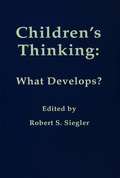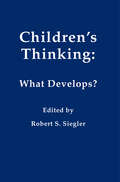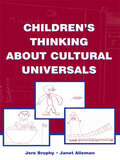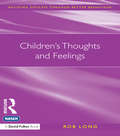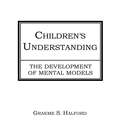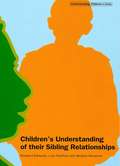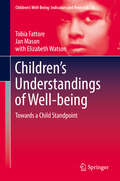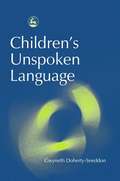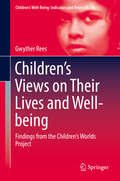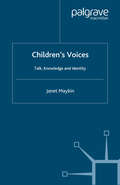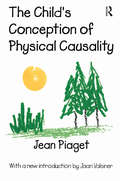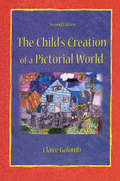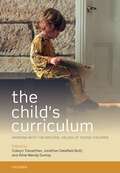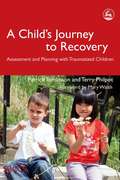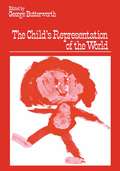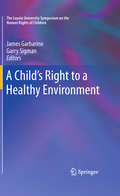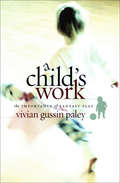- Table View
- List View
Children's Thinking: What Develops? (Carnegie Mellon Symposia on Cognition Series)
by Robert SieglerFirst published in 1978. Routledge is an imprint of Taylor & Francis, an informa company.
Children's Thinking: What Develops? (Carnegie Mellon Symposia on Cognition Series)
by Robert S. SieglerFirst published in 1978. Routledge is an imprint of Taylor & Francis, an informa company.
Children's Thinking About Cultural Universals
by Jere Brophy Janet AllemanDrawing on interview data, the authors describe K-3 students' knowledge and thinking about basic aspects of the social world that are addressed in the elementary social studies curriculum. The interviews focused on human activities relating to nine cultural universals that are commonly addressed in the elementary social studies curriculum: food, clothing, shelter, communication, transportation, family living, childhood, money, and government. This volume synthesizes findings from the research and discusses their implications for curriculum and instruction in early social studies.Children's Thinking About Cultural Universals significantly expands the knowledge base on developments in children's social knowledge and thinking and, in addition, provides a wealth of information to inform social studies educators' and curriculum developers' efforts to match instruction to students' prior knowledge, both by building on already developed valid knowledge and by addressing common misconceptions. It represents a quantum leap in the availability of information on the trajectories of children's knowledge about common topics in primary elementary social studies education.
Children's Thinking About Cultural Universals
by Jere Brophy Janet AllemanDrawing on interview data, the authors describe K-3 students' knowledge and thinking about basic aspects of the social world that are addressed in the elementary social studies curriculum. The interviews focused on human activities relating to nine cultural universals that are commonly addressed in the elementary social studies curriculum: food, clothing, shelter, communication, transportation, family living, childhood, money, and government. This volume synthesizes findings from the research and discusses their implications for curriculum and instruction in early social studies.Children's Thinking About Cultural Universals significantly expands the knowledge base on developments in children's social knowledge and thinking and, in addition, provides a wealth of information to inform social studies educators' and curriculum developers' efforts to match instruction to students' prior knowledge, both by building on already developed valid knowledge and by addressing common misconceptions. It represents a quantum leap in the availability of information on the trajectories of children's knowledge about common topics in primary elementary social studies education.
Children's Thoughts and Feelings: Children's Thoughts And Feelings (nasen spotlight)
by Rob LongUnderstanding how children think and feel is the key to buiding good relationships in the classroom. This book looks at: underlying causes of emotional conflicts the nature of maladaptive coping mechanisms why boys tend to "act out" and girls ten to "act in" interventions to promote the use of adaptive coping styles.
Children's Thoughts and Feelings (nasen spotlight)
by Rob LongUnderstanding how children think and feel is the key to buiding good relationships in the classroom. This book looks at: underlying causes of emotional conflicts the nature of maladaptive coping mechanisms why boys tend to "act out" and girls ten to "act in" interventions to promote the use of adaptive coping styles.
Children's Understanding: The Development of Mental Models
by Graeme S. HalfordThis work argues that cognitive development is experience driven, and processes entailed in acquiring information about the world are analyzed based on recent models of learning and induction. The way information is represented and accessed when performing cognitive tasks is considered paying particular attention to the implications of Parallel Distributed Processing (PDP) models for cognitive development. The first half of the book contains analyses of human reasoning processes (drawing on PDP models of analogy), development of strategies, and task complexity -- all based on aspects of PDP representations. It is proposed that PDP representations become more differentiated with age, so more vectors can be processed in parallel, with the result that structures of greater complexity can be processed. This model gives an account of previously unexplained difficulties in children's reasoning, including some which were influential in stage theories. The second half of the book examines processes entailed in some representative cognitive developmental tasks, including transitive inference, deductive inference (categorical syllogisms), hypothesis testing, learning set acquisition, acquisition and transfer of relational structures, humor, hierarchical classification and inclusion, understanding of quantity, arithmetic word problems, algebra, conservation, mechanics, and the concept of mind. Process accounts of tasks are emphasized, based on applications of recent developments in cognitive science.
Children's Understanding: The Development of Mental Models
by Graeme S. HalfordThis work argues that cognitive development is experience driven, and processes entailed in acquiring information about the world are analyzed based on recent models of learning and induction. The way information is represented and accessed when performing cognitive tasks is considered paying particular attention to the implications of Parallel Distributed Processing (PDP) models for cognitive development. The first half of the book contains analyses of human reasoning processes (drawing on PDP models of analogy), development of strategies, and task complexity -- all based on aspects of PDP representations. It is proposed that PDP representations become more differentiated with age, so more vectors can be processed in parallel, with the result that structures of greater complexity can be processed. This model gives an account of previously unexplained difficulties in children's reasoning, including some which were influential in stage theories. The second half of the book examines processes entailed in some representative cognitive developmental tasks, including transitive inference, deductive inference (categorical syllogisms), hypothesis testing, learning set acquisition, acquisition and transfer of relational structures, humor, hierarchical classification and inclusion, understanding of quantity, arithmetic word problems, algebra, conservation, mechanics, and the concept of mind. Process accounts of tasks are emphasized, based on applications of recent developments in cognitive science.
Children's Understanding of their Sibling Relationships (PDF)
by Lucy Hadfield Melanie Mauthner Rosalind EdwardsSibling relationships are both patterned and diverse. This report provides an 'insider' perspective on these relationships and highlights their complexity. This book draws on research which explores the views of children in middle childhood, aged between 7 and 13. It shows that relationships varying according to context, with gender and the age hierarchy as important features.
Children’s Understandings of Well-being: Towards a Child Standpoint (Children’s Well-Being: Indicators and Research #14)
by Tobia Fattore Jan Mason Elizabeth WatsonThe book presented here describes an outstanding attempt, not only to include children’s views but to partner with children to develop the concept of well-being and to study the phenomenon as the children understand it. The authors do this by placing the concept of children’s well-being within the existing discourses on the topic and by developing their unique theoretical approach to the concept. Then, and based on what children told them, the authors identify different domains and dimensions of children’s well-being and touch upon its multifaceted nature. The book concludes with drawing research and policy implications from an integrated summary of the study’s findings and lists indicator concepts that present an alternative framework and conceptualisation of well-being from a child standpoint.
Children's Unspoken Language
by Gwyneth Doherty-SneddonGwyneth Doherty-Sneddon, a developmental psychologist and the mother of two young children, demonstrates the way in which a young child's developing personality and intelligence is revealed through non-verbal communication. She shows how parents and other adults have the potential to facilitate a child's social and intellectual growth through acknowledging and responding to this unspoken language. Taking an in-depth look at four of the channels of non-verbal communication - hand gesture, facial expression, eye gaze and touch - this accessible text follows the development of young children from birth to late primary school age. Using jargon-free language Children's Unspoken Language is invaluable reading for parents and professionals alike.
Children's Unspoken Language (PDF)
by Gwyneth Doherty-SneddonGwyneth Doherty-Sneddon, a developmental psychologist and the mother of two young children, demonstrates the way in which a young child's developing personality and intelligence is revealed through non-verbal communication. She shows how parents and other adults have the potential to facilitate a child's social and intellectual growth through acknowledging and responding to this unspoken language. Taking an in-depth look at four of the channels of non-verbal communication - hand gesture, facial expression, eye gaze and touch - this accessible text follows the development of young children from birth to late primary school age. Using jargon-free language Children's Unspoken Language is invaluable reading for parents and professionals alike.
Children’s Views on Their Lives and Well-being: Findings from the Children’s Worlds Project (Children’s Well-Being: Indicators and Research #18)
by Gwyther ReesThis book presents a comprehensive overview of findings from the Children’s Worlds project – the most extensive and diverse study to have been conducted globally on children’s own views of their lives. It provides a unique comparative insight into the similarities and differences in children’s lives and well-being around the world, including findings that challenge prevailing assumptions of where, and in what contexts, children might experience a ‘good childhood’. The book draws out the key messages and implications from the study and identifies directions for future work on child well-being. It will be of interest to researchers and students in the field of childhood studies, as well as a wide range of professionals and organisations concerned with improving children’s quality of life.
Children's Voices: Talk, Knowledge and Identity
by J. MaybinJanet Maybin investigates how 10-12 year-olds use talk and literacy to construct knowledge about their social worlds and themselves. She shows how children use collaborative verbal strategies, stories of personal experience and the reworked voices of others to investigate the moral order and forge their own identities.
The Child's Conception of Physical Causality
by Jean PiagetOur encounters with the physical world are filled with miraculous puzzles-wind appears from somewhere, heavy objects (like oil tankers) float on oceans, yet smaller objects go to the bottom of our water-filled buckets. As adults, instead of confronting a whole world, we are reduced to driving from one parking garage to another. The Child's Conception of Physical Causality, part of the very beginning of the ground-breaking work of the Swiss naturalist Jean Piaget, is filled with creative experimental ideas for probing the most sophisticated ways of thinking in children.The strength of Piaget's research is evident in this collection of empirical data, systematically organized by tasks that illuminate how things work. Piaget's data are remarkably rich. In his new introduction, Jaan Valsiner observes that Piaget had no grand theoretical aims, yet the book's simple power cannot be ignored. Piaget's great contribution to developmental psychology was his "clinical method"-a tactic that integrated relevant aspects of naturalistic experiment, interview, and observation. Through this systematic inquiry, we gain insight into children's thinking.Reading Piaget will encourage the contemporary reader to think about the unity of psychological phenomena and their theoretical underpinnings. His wealth of creative experimental ideas probes into the most sophisticated ways of thinking in children. Technologies change, yet the creative curiosity of children remains basically unhindered by the consumer society. Piaget's data preserve the reality of the original phenomena. As such, this work will provide a wealth of information for developmental psychologists and those involved in the field of experimental science.
The Child's Conception of Physical Causality (International Library Of Psychology Ser.)
by Jean PiagetOur encounters with the physical world are filled with miraculous puzzles-wind appears from somewhere, heavy objects (like oil tankers) float on oceans, yet smaller objects go to the bottom of our water-filled buckets. As adults, instead of confronting a whole world, we are reduced to driving from one parking garage to another. The Child's Conception of Physical Causality, part of the very beginning of the ground-breaking work of the Swiss naturalist Jean Piaget, is filled with creative experimental ideas for probing the most sophisticated ways of thinking in children.The strength of Piaget's research is evident in this collection of empirical data, systematically organized by tasks that illuminate how things work. Piaget's data are remarkably rich. In his new introduction, Jaan Valsiner observes that Piaget had no grand theoretical aims, yet the book's simple power cannot be ignored. Piaget's great contribution to developmental psychology was his "clinical method"-a tactic that integrated relevant aspects of naturalistic experiment, interview, and observation. Through this systematic inquiry, we gain insight into children's thinking.Reading Piaget will encourage the contemporary reader to think about the unity of psychological phenomena and their theoretical underpinnings. His wealth of creative experimental ideas probes into the most sophisticated ways of thinking in children. Technologies change, yet the creative curiosity of children remains basically unhindered by the consumer society. Piaget's data preserve the reality of the original phenomena. As such, this work will provide a wealth of information for developmental psychologists and those involved in the field of experimental science.
The Child's Creation of A Pictorial World
by Claire GolombThis book places child art within the broader context of children's creative intelligence and intrinsic motivation to invent a pictorial world. It examines the development of drawing and painting from several currently dominant theoretical perspectives. This is followed by an extensive examination of empirical data on the art work of children who are ordinary, talented, emotionally disturbed, and atypically developed due to mental disability or autism. The Child's Creation of a Pictorial World uses a developmental framework that combines theoretical sophistication with rigorous empirical investigations into the mental processes that underlie the child's drawings. It delineates the evolution of forms, the pictorial differentiation of figures and their spatial relations, the role of color in narrative descriptions, and its expressive function. Artistic development across all these dimensions is seen as a meaningful mental activity that serves cognitive, affective, and aesthetic functions.
The Child's Creation of A Pictorial World
by Claire GolombThis book places child art within the broader context of children's creative intelligence and intrinsic motivation to invent a pictorial world. It examines the development of drawing and painting from several currently dominant theoretical perspectives. This is followed by an extensive examination of empirical data on the art work of children who are ordinary, talented, emotionally disturbed, and atypically developed due to mental disability or autism. The Child's Creation of a Pictorial World uses a developmental framework that combines theoretical sophistication with rigorous empirical investigations into the mental processes that underlie the child's drawings. It delineates the evolution of forms, the pictorial differentiation of figures and their spatial relations, the role of color in narrative descriptions, and its expressive function. Artistic development across all these dimensions is seen as a meaningful mental activity that serves cognitive, affective, and aesthetic functions.
The Child's Curriculum: Working with the Natural Values of Young Children
by Colwyn Trevarthen Aline-Wendy Dunlop Jonathan Delafield-ButtAll children are born with emotional talent. But if left untended, those talents can wane during the first five years of life. Children are sensitive and social beings from birth, exhibiting an innate enthusiasm for communication that must be satisfied for healthy development. If their feelings, agency, and motivations are met with affection, if they are respected and nurtured, then children will respond creatively and that inherent desire for companionship will flourish. However, with the recent changes in political and educational systems, early years education has seen a decline in focus on the emotional wellbeing of children and the development of their creativity. Those systems need to adapt if educators are to bring out the best in our future generations. By nurturing creativity and emotional wellbeing in the first five years of life, long term social benefits can be wrought. The book focusses on children's readiness for learning. It addresses the natural joy explicit in children's early conversations and engagement with music and their development through play with both adults and other children. This kind of education allows children to develop their bodies and skills, accept and understand their feelings, build relationships, and progress both their imagination and their problem solving skills. In this way, play with others drives development. With contributors from the fields of psychological, educational, and political spheres, this book will be of interest to anyone concerned for the future of our children.
The Child's Curriculum: Working with the Natural Values of Young Children
All children are born with emotional talent. But if left untended, those talents can wane during the first five years of life. Children are sensitive and social beings from birth, exhibiting an innate enthusiasm for communication that must be satisfied for healthy development. If their feelings, agency, and motivations are met with affection, if they are respected and nurtured, then children will respond creatively and that inherent desire for companionship will flourish. However, with the recent changes in political and educational systems, early years education has seen a decline in focus on the emotional wellbeing of children and the development of their creativity. Those systems need to adapt if educators are to bring out the best in our future generations. By nurturing creativity and emotional wellbeing in the first five years of life, long term social benefits can be wrought. The book focusses on children's readiness for learning. It addresses the natural joy explicit in children's early conversations and engagement with music and their development through play with both adults and other children. This kind of education allows children to develop their bodies and skills, accept and understand their feelings, build relationships, and progress both their imagination and their problem solving skills. In this way, play with others drives development. With contributors from the fields of psychological, educational, and political spheres, this book will be of interest to anyone concerned for the future of our children.
A Child's Journey to Recovery: Assessment and Planning with Traumatized Children
by Mary Walsh Patrick Tomlinson Terry PhilpotThis book shows how carefully planned and assessed treatment can help traumatized children. It outlines how to set up a process for measuring a child's progress towards recovery. Uniquely, the book describes a practical outcomes-based approach that can be provided by an integrated multi-disciplinary team. Particular themes addressed include the conflict between the child's chronological and emotional ages, the need to work at the child's pace, the importance of the whole-team approach, and the challenges involved in measuring progress. The authors describe clearly defined outcomes for recovery, how children are assessed and how recovery plans are made, and show how progress can be closely monitored and responded to through the continuing process of assessment. An in-depth case study is used to show how this works in practice. This book forms part of an integrated approach and is an ideal accompaniment to existing titles in the SACCS `Delivering Recovery' series.
A Child's Journey to Recovery: Assessment and Planning with Traumatized Children (PDF)
by Mary Walsh Patrick Tomlinson Terry PhilpotThis book shows how carefully planned and assessed treatment can help traumatized children. It outlines how to set up a process for measuring a child's progress towards recovery. Uniquely, the book describes a practical outcomes-based approach that can be provided by an integrated multi-disciplinary team. Particular themes addressed include the conflict between the child's chronological and emotional ages, the need to work at the child's pace, the importance of the whole-team approach, and the challenges involved in measuring progress. The authors describe clearly defined outcomes for recovery, how children are assessed and how recovery plans are made, and show how progress can be closely monitored and responded to through the continuing process of assessment. An in-depth case study is used to show how this works in practice. This book forms part of an integrated approach and is an ideal accompaniment to existing titles in the SACCS `Delivering Recovery' series.
The Child’s Representation of the World
by George ButterworthAlthough central to theories of cognitive development, the concept of representation remains subtle and elusive. This collection of papers reflects a variety of individual emphases, none of which are mutually exclusive. The papers have been arranged in four groups, mainly along lines of related subject matter but also to illustrate different aspects of the development of representation. In Piaget's theory, representation is defined as "the making present of an object which is not present to the senses" (Furth 1969). Representation has both a figurative and an operative aspect. The organisation of the content of the representation (the figurative aspect) depends on the operations of thought or on the schemes co-ordinating action. This use of the term is applic able both to internal representations, such as visual images and to external representation, such as children's drawings. However, it presupposes no necessary relation between a mental image and a graphic representation. The first part of the book consists of papers on children's drawing. The operative aspect of representation emerges in the serial ordering problems encountered by young children who produce "tadpole" figures (Freeman Chapter 1). The figurative aspect of graphic representation is vividly illustrated by the drawings of the autistic child Nadia (Selfe Chapter 2). One further issue which emerges concerns the relation between linguistic and graphic representation.
A Child's Right to a Healthy Environment (The Loyola University Symposium on the Human Rights of Children #1)
by James Garbarino Garry SigmanIt’s a startling reality that more American children are victims—and perpetrators—of violence than those of any other developed country. Yet unlike the other nations, the United States has yet to ratify the United Nations Convention on the Rights of the Child. Compelling, readable, and interdisciplinary, A Child’s Right to a Healthy Environment provides an abundance of skilled observation, important findings, and keen insights to place children’s well-being in the vanguard of human rights concerns, both in the United States and globally.Within this volume, authors examine the impediments to the crucial goals of justice, safety, dignity, well-being, and meaning in children’s lives, factors as varied as socioeconomic stressors, alienated, disengaged parents, and corrosive moral lessons from the media. The complex role of religious institutions in promoting and, in many cases, curtailing children’s rights is analyzed, as are international efforts by advocates and policymakers to address major threats to children’s development, including:War and natural disasters.Environmental toxins (e.g., malaria and lead poisoning).The child obesity epidemic.Gun violence.Child slavery and trafficking.Toxic elements in contemporary culture.A Child’s Right to a Healthy Environment is a powerful call to action for researchers and professionals in developmental, clinical child, school, and educational psychology as well as psychiatry, pediatrics, social work, general and special education, sociology, and other fields tasked with improving children’s lives.
A Child's Work: The Importance of Fantasy Play
by Vivian Gussin PaleyThe buzz word in education today is accountability. But the federal mandate of "no child left behind" has come to mean curriculums driven by preparation for standardized tests and quantifiable learning results. Even for very young children, unstructured creative time in the classroom is waning as teachers and administrators are under growing pressures to measure school readiness through rote learning and increased homework. In her new book, Vivian Gussin Paley decries this rapid disappearance of creative time and makes the case for the critical role of fantasy play in the psychological, intellectual, and social development of young children. A Child's Work goes inside classrooms around the globe to explore the stunningly original language of children in their role-playing and storytelling. Drawing from their own words, Paley examines how this natural mode of learning allows children to construct meaning in their worlds, meaning that carries through into their adult lives. Proof that play is the work of children, this compelling and enchanting book will inspire and instruct teachers and parents as well as point to a fundamental misdirection in today's educational programs and strategies.
